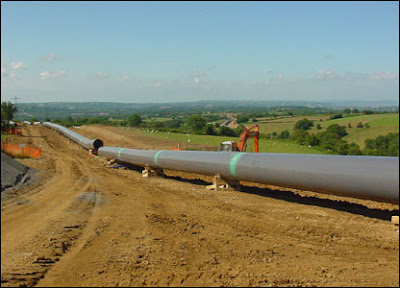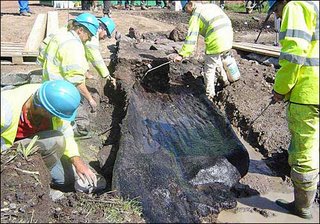LNG Jack-up accident: Something Deeper At Work?
Let's picture the scene: A major Seaway on the West coast of the UK. A massive energy project under a tight construction schedule. An accident occurs involving a "Jack-up" Barge, which begins to list precariously into the sea. The workers, mostly Dutch, are quickly evacuated.
Are we talking about Milford Haven?
Nope. We're talking about the
Solway Firth, on the West Coast of Scotland. Just over three weeks ago, a similar jack-up accident occured, under remarkably similar circumstances. Thirty eight contractors working on the massive Robin Rigg offshore wind-farm project were airlifted to safety in that case.
Contractors working on South Hook were not so lucky, and the Big Welsh Gas Project has now claimed it's first casualty. So what's behind this sudden spate of accidents?
In the case of Robin Rigg, German energy giant EON told a local coastguard that the rig had actually punctured through the sea bed. In industry parlance, this is known as "foundation failure." Jack-up barges, supported on four legs, are adjustable to allow them to rest securely on the sea bottom. But accidents do happen in the industry. As the Solway puncture occured, the rig listed, in this case at an angle of 35 degrees.
And not dissimilar to the 45 degree tilt reported at Milford...
The parallels don't end there either. The Dutch company which owns the Solway barge, SMIT International, recently sent another jack-up, TAKLIFT 7, to Milford Haven to work on the South Hook Jetty. These guys get about, don't they...
Needless to say, the Solway accident prompted the intervention of the Health and Safety Executive, as it has in Milford Haven. But in the case of South Hook, all the authorities seem to be keeping their cards close to their chests. No doubt the magic mantra; "20% of the UK's gas supply" has been whispered in the ears of the tiny HSE team assigned to this huge project, and they've shut up like little clams...
So rather than wait for the HSE to open up, let's be a little more pro-active and take a look at the HSE's own Industry guidance. In 2004, the Offshore Division of the HSE's Hazardous Installations Directorate produced a Science and Technology Strategy Document" which looked at precisely this issue of foundation failure.
This strategy was produced in relation to the newly developing Offshore Wind industry, but as the report pointed out 3 years before these two accidents occured; "There have already been potentially serious accidents (heavy lift crane collapse and jack-up foundation failure during site investigation)" and that "Jack-up barges have a history of structural and foundation failures when engaged in inshore and near-shore construction work."
"There is a need to determine the adequacy of current practices for the design and operation of construction barges and, if found inadequate, work with the industry to develop guidance on good practice."
Was such guidance developed in relation to LNG?
Given that the Milford Haven Port Authority has now finally given way to the demands of concerned locals and the Safe Haven group and agreed to release the
Risk Assessments for the South Hook jetty, an inquiry into the causes of this particular incident seems particularly pertinent...
 A day after the European Commission agreed to look into the LNG project, a story of great significance to Welsh campaigners appeared on BBC Online.
A day after the European Commission agreed to look into the LNG project, a story of great significance to Welsh campaigners appeared on BBC Online.




















